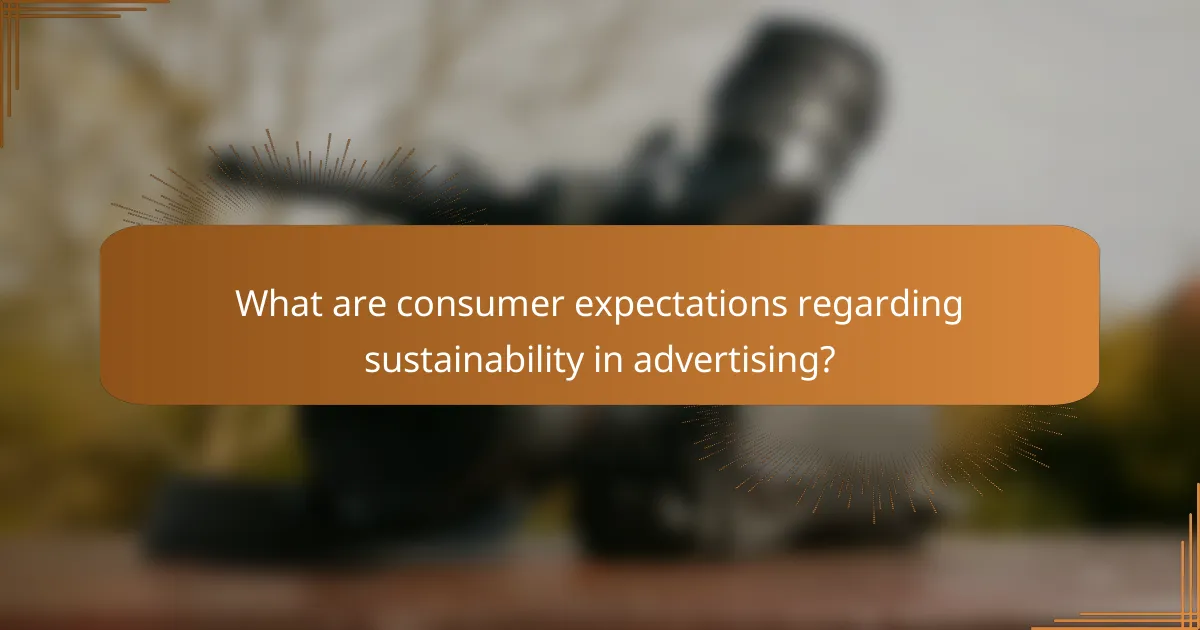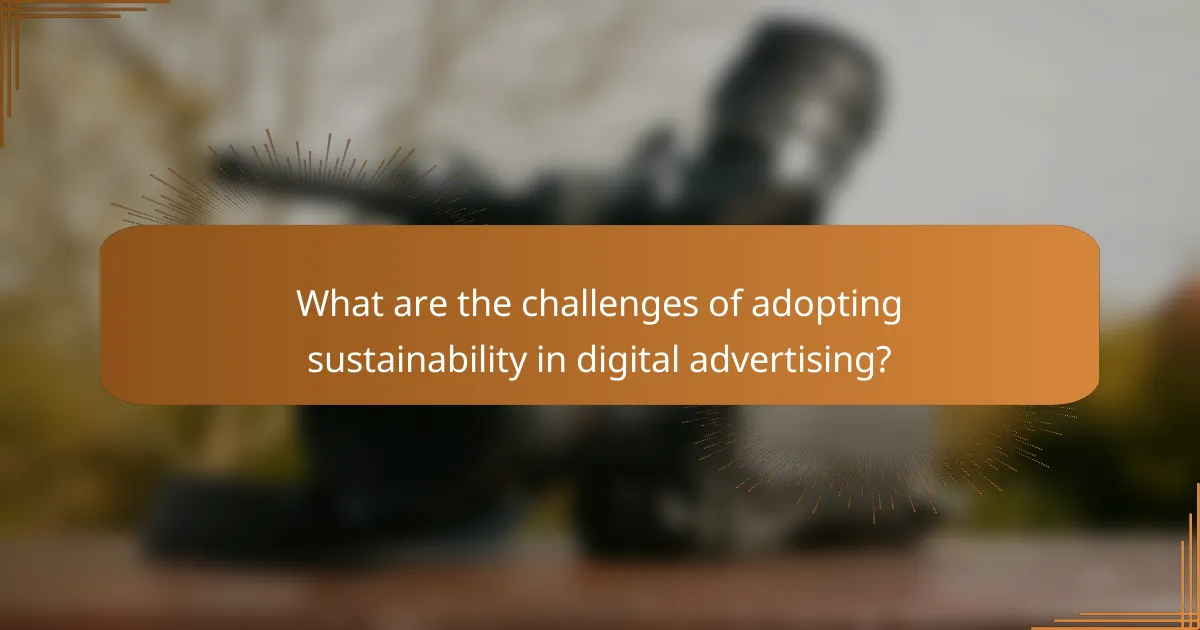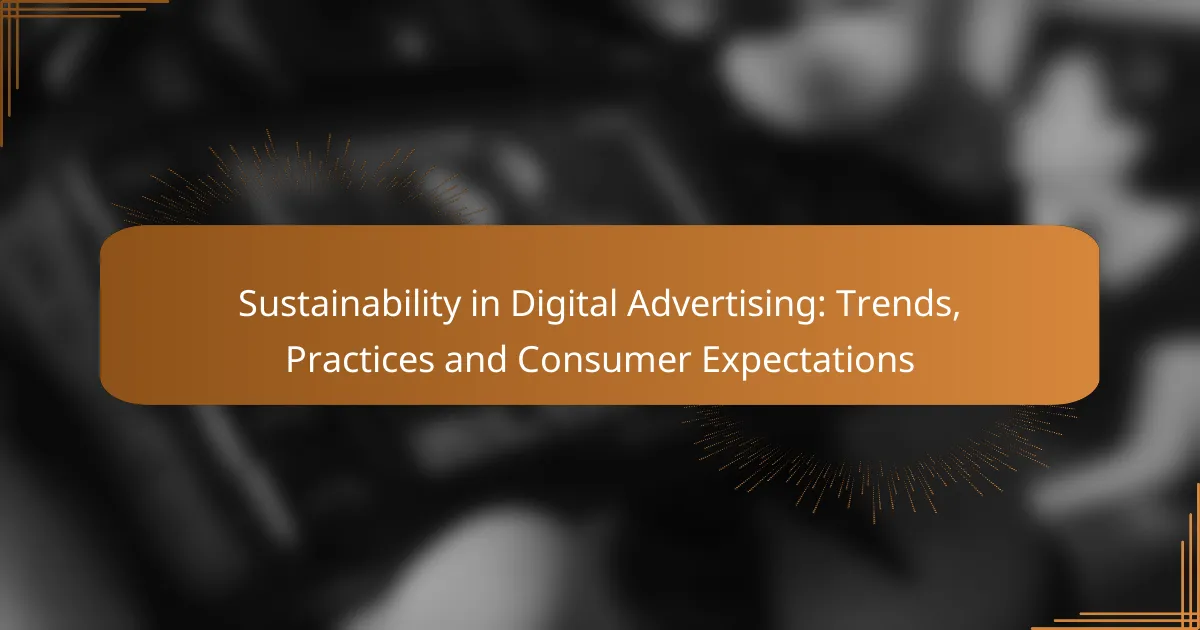Sustainability is becoming a pivotal factor in digital advertising as brands and consumers alike emphasize eco-friendly practices. This transformation is driving advertisers to embrace greener strategies and technologies, aligning their efforts with consumer expectations and regulatory demands. Key trends include the adoption of carbon-neutral initiatives and the integration of sustainability metrics, reflecting a growing consumer desire for responsible marketing practices.

How is sustainability shaping digital advertising in the US?
Sustainability is increasingly influencing digital advertising in the US as brands and consumers prioritize eco-friendly practices. This shift is prompting advertisers to adopt greener strategies and platforms to align with consumer expectations and regulatory standards.
Increased demand for eco-friendly practices
There is a growing demand among consumers for brands to implement eco-friendly practices in their advertising efforts. This includes using sustainable materials for promotional items, reducing carbon footprints in digital campaigns, and ensuring transparency in sourcing and production processes.
Advertisers are responding by integrating sustainability into their core strategies. For example, brands may choose to highlight their environmental initiatives in ads or partner with organizations focused on sustainability to enhance their credibility.
Shift towards sustainable ad platforms
Many advertisers are now shifting towards sustainable ad platforms that prioritize eco-friendly technologies and practices. These platforms often utilize renewable energy sources for data centers and aim to minimize waste in their operations.
Choosing such platforms can not only reduce a brand’s carbon footprint but also resonate with environmentally conscious consumers. Advertisers should evaluate platforms based on their sustainability certifications and practices to ensure alignment with their green goals.
Consumer preference for green brands
Consumers are increasingly favoring brands that demonstrate a commitment to sustainability. Research indicates that a significant portion of the population is willing to pay more for products from environmentally responsible companies.
To capitalize on this trend, brands should clearly communicate their sustainability efforts in their advertising. This could involve showcasing eco-friendly product features, sharing stories about sustainable sourcing, or highlighting partnerships with environmental organizations.

What are the key trends in sustainable digital advertising?
Key trends in sustainable digital advertising include the rise of carbon-neutral initiatives, the integration of sustainability metrics into campaigns, and the use of renewable energy sources in advertising technology. These trends reflect a growing consumer demand for environmentally responsible practices in marketing.
Rise of carbon-neutral advertising
The rise of carbon-neutral advertising involves brands committing to offset their carbon emissions generated through digital campaigns. This can be achieved by investing in carbon offset projects, such as reforestation or renewable energy initiatives, which help balance out the environmental impact of their advertising efforts.
Brands are increasingly transparent about their carbon footprints, often sharing their sustainability goals with consumers. For example, some companies provide calculators on their websites to show how they offset emissions, enhancing consumer trust and engagement.
Integration of sustainability metrics
Integrating sustainability metrics into digital advertising allows brands to measure the environmental impact of their campaigns. This includes tracking metrics like carbon emissions, energy consumption, and waste generation associated with ad delivery and production.
Advertisers can use these metrics to optimize their strategies, focusing on channels and practices that minimize environmental impact. For instance, choosing platforms that prioritize eco-friendly practices can significantly reduce a campaign’s carbon footprint.
Use of renewable energy in ad tech
The use of renewable energy in ad tech is becoming a standard practice as companies seek to power their operations sustainably. Many ad tech firms are transitioning to renewable energy sources, such as solar or wind, to reduce their reliance on fossil fuels.
Brands can support this trend by partnering with ad tech providers that prioritize renewable energy. This not only contributes to sustainability goals but can also resonate with eco-conscious consumers, enhancing brand loyalty and reputation.

How can brands implement sustainable practices in display advertising?
Brands can implement sustainable practices in display advertising by focusing on eco-friendly hosting, creative strategies, and partnerships with environmentally conscious vendors. These approaches not only reduce carbon footprints but also resonate with increasingly eco-aware consumers.
Adopting green hosting solutions
Green hosting solutions involve using data centers that prioritize renewable energy sources, such as wind or solar power. Brands should look for hosting providers that are certified by recognized standards like Green Seal or Energy Star.
When selecting a green hosting provider, consider factors such as energy efficiency, server location, and their commitment to sustainability. A good practice is to compare the carbon offset initiatives of different providers to ensure alignment with your brand’s sustainability goals.
Utilizing sustainable creative strategies
Sustainable creative strategies focus on minimizing resource use while maximizing impact. This can include optimizing ad file sizes to reduce bandwidth consumption and using fewer resources in the design process.
Brands can also adopt a minimalist design approach, which not only appeals to consumers but also reduces the environmental impact of digital ads. Testing different formats and placements can help identify the most effective strategies that also align with sustainability goals.
Partnering with eco-conscious vendors
Partnering with eco-conscious vendors ensures that all aspects of the advertising supply chain adhere to sustainable practices. Look for vendors who prioritize sustainability in their operations, such as those that use recycled materials or have sustainable packaging solutions.
Establishing clear sustainability criteria when selecting vendors can streamline the process and enhance brand credibility. Regularly review vendor practices to ensure they continue to meet your sustainability standards and consider collaborating on joint initiatives that promote environmental responsibility.

What are consumer expectations regarding sustainability in advertising?
Consumers increasingly expect brands to demonstrate sustainability in their advertising efforts. This includes a demand for transparency, authenticity, and a focus on sustainable product offerings that align with their values.
Transparency in ad practices
Transparency in advertising means that brands should openly communicate their sustainability practices and the environmental impact of their products. Consumers want to know how their purchases affect the planet, which can include details about sourcing, production methods, and supply chain practices.
Brands can enhance transparency by providing clear information on their websites, using eco-labels, and sharing sustainability reports. This openness builds trust and can significantly influence consumer purchasing decisions.
Authenticity in brand messaging
Authenticity in brand messaging refers to the genuine portrayal of a brand’s commitment to sustainability. Consumers are adept at spotting insincerity, so brands must ensure that their claims are backed by real actions and not just marketing gimmicks.
To convey authenticity, brands should highlight specific initiatives, such as partnerships with environmental organizations or certifications from recognized sustainability standards. This approach fosters a deeper connection with consumers who prioritize ethical consumption.
Preference for sustainable product offerings
Consumers are increasingly favoring products that are marketed as sustainable, leading to a shift in purchasing behavior. This preference can manifest in a willingness to pay a premium for eco-friendly products or to choose brands that prioritize sustainability in their offerings.
Brands should consider expanding their product lines to include sustainable options, such as biodegradable packaging or ethically sourced materials. Highlighting these offerings in advertising can attract environmentally conscious consumers and differentiate the brand in a competitive market.

What frameworks can guide sustainable advertising decisions?
Frameworks for sustainable advertising decisions help marketers align their strategies with environmental and social responsibility. These frameworks provide guidelines and best practices that can enhance brand reputation while meeting consumer expectations for sustainability.
Guidelines from the Interactive Advertising Bureau
The Interactive Advertising Bureau (IAB) offers guidelines that emphasize transparency and accountability in digital advertising. These guidelines encourage advertisers to disclose their sustainability efforts and the environmental impact of their campaigns.
Key considerations include optimizing ad delivery to reduce energy consumption and utilizing data responsibly to minimize waste. Advertisers are urged to adopt eco-friendly technologies and practices, such as energy-efficient servers and sustainable media buying strategies.
Best practices from the Sustainable Advertising Coalition
The Sustainable Advertising Coalition provides best practices that focus on integrating sustainability into every aspect of advertising. This includes setting measurable sustainability goals and regularly reporting on progress to stakeholders.
Advertisers should prioritize partnerships with eco-conscious suppliers and platforms. Additionally, implementing a circular economy approach—where resources are reused and recycled—can significantly reduce the environmental footprint of advertising campaigns.

What are the challenges of adopting sustainability in digital advertising?
Adopting sustainability in digital advertising involves navigating several challenges, including balancing costs, measuring the effectiveness of sustainable practices, and aligning with consumer expectations. Companies must consider how to implement eco-friendly strategies without significantly increasing their budgets or compromising campaign performance.
Balancing cost and sustainability
One of the primary challenges in adopting sustainable practices in digital advertising is the potential increase in costs. Sustainable options, such as using green hosting services or investing in carbon offset programs, can be more expensive than traditional methods. Businesses need to evaluate the long-term benefits of sustainability against immediate financial impacts.
To manage costs effectively, companies can prioritize sustainable initiatives that offer the highest return on investment. For example, optimizing ad targeting can reduce waste and improve efficiency, making campaigns more cost-effective while also being environmentally responsible. Establishing partnerships with sustainable vendors can also help mitigate expenses.
Measuring the impact of sustainable practices
Measuring the impact of sustainable practices in digital advertising can be complex. Companies often struggle to quantify the environmental benefits of their efforts, making it difficult to assess their effectiveness. Implementing standardized metrics and reporting frameworks can help organizations track their sustainability performance more accurately.
Utilizing tools such as carbon calculators or sustainability dashboards can provide insights into the environmental impact of advertising campaigns. Regularly reviewing these metrics allows businesses to adjust their strategies and improve their sustainability efforts over time. Engaging consumers through transparency about sustainability initiatives can also enhance brand loyalty and trust.

How do emerging technologies influence sustainable advertising?
Emerging technologies significantly shape sustainable advertising by enhancing efficiency and reducing environmental impact. Innovations like artificial intelligence and blockchain facilitate more targeted campaigns, minimizing waste and optimizing resource use.
Artificial Intelligence in Advertising
Artificial intelligence (AI) plays a crucial role in sustainable advertising by enabling data-driven decision-making. AI algorithms analyze consumer behavior, allowing brands to create personalized ads that resonate with their audience while reducing unnecessary impressions.
For instance, AI can help identify the most effective channels for ad placement, ensuring that marketing budgets are spent efficiently. This targeted approach not only improves engagement rates but also decreases the carbon footprint associated with broader, less effective campaigns.
Blockchain for Transparency
Blockchain technology enhances transparency in digital advertising, which is vital for sustainability. By providing a decentralized ledger, blockchain allows advertisers to track the entire supply chain of their ads, ensuring that resources are used responsibly.
For example, brands can verify that their ads are displayed on reputable platforms and that their spending directly supports sustainable practices. This transparency builds consumer trust and encourages brands to adopt more environmentally friendly advertising strategies.
Data Analytics and Measurement
Data analytics is essential for measuring the effectiveness of sustainable advertising efforts. By utilizing analytics tools, companies can assess the performance of their campaigns and identify areas for improvement, leading to more sustainable practices over time.
Marketers should focus on key performance indicators (KPIs) such as engagement rates, conversion rates, and return on investment (ROI) to evaluate their strategies. Regularly reviewing these metrics allows brands to pivot quickly and adopt more sustainable advertising methods as needed.



